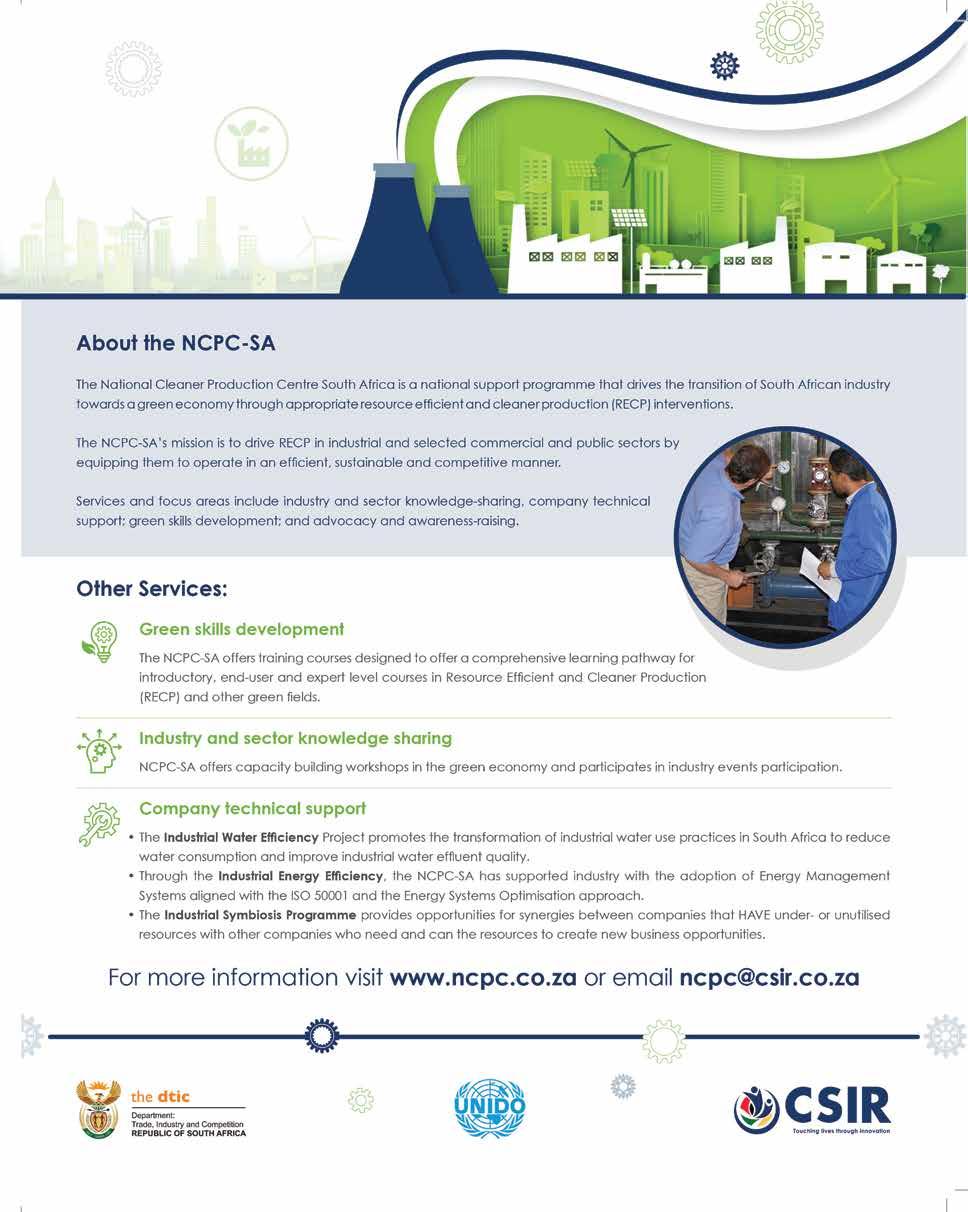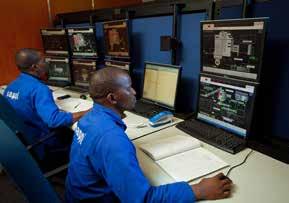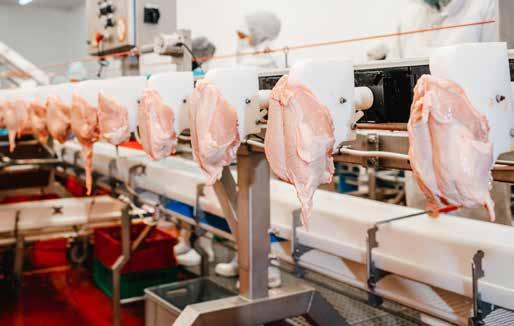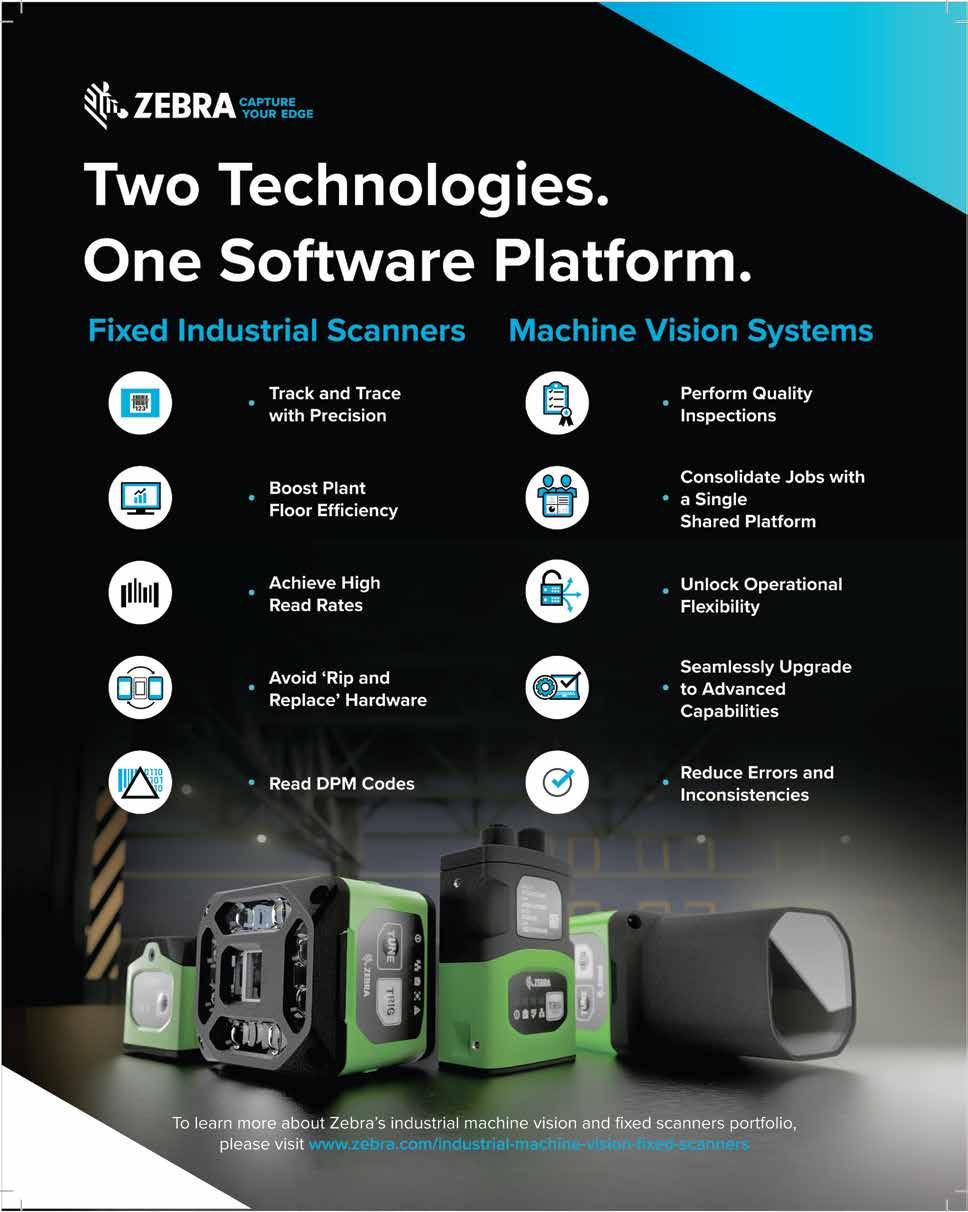MANUFACTURING
MINING
What does a just energy transition mean for Mpumalanga?


MINING
What does a just energy transition mean for Mpumalanga?


Will 5G unlock real-time tracking and location solutions for automotive manufacturers in South Africa?
Inside: ERP SYSTEMS | ELECTRICITY RATE HIKES | SPECIAL ECONOMIC ZONES





PUBLISHED BY Picasso Headline,
A proud division of Arena Holdings (Pty) Ltd, Hill on Empire, 16 Empire Road (cnr Hillside Road), Parktown, Johannesburg, 2193 PO Box 12500, Mill Street, Cape Town, 8010 www.businessmediamags.co.za
EDITORIAL
Editor: Anthony Sharpe
Content Manager: Raina Julies rainaj@picasso.co.za
Contributors: Trevor Crighton, James Francis, Neil Gouveia, Doug Hunter, Dr Lisa Kinnear, Vukani Magubane, Rodney Weidemann
Copy Editor: Brenda Bryden
Content Co-ordinator: Natasha Maneveldt
Digital Editor: Stacey Visser vissers@businessmediamags.co.za
DESIGN
Head of Design: Jayne Macé-Ferguson
Senior Designer: Mfundo Archie Ndzo
Advert Designer: Bulelwa Sotashe
Cover Image: istockphoto.com/
SALES
In January, economist Dr Roelof Botha published a refreshingly optimistic article about the resilience of the South African manufacturing sector. To be fair, to manufacture anything in South Africa, you must be resilient. The ability to recover from setbacks is an essential part of life in a country beset by power cuts, crime, corruption, impotent leadership, inflation, you name it.
In this issue of Manufacturing, we look at research that shows resilience is actually a great predictor of future success, but it requires leadership that is conscious of how their responses to crises affect others.
That sort of consciousness is at the heart of the Just Energy Transition Investment Plan, which aims to mitigate the negative impacts of the switch to renewables on communities dependent on the fossil fuel value chain. Nowhere is that more important than in Mpumalanga, the coal-mining and -burning
heart of the country, so we explore the province’s options moving forward.
Energy is a burning topic for all businesses, which are feeling the pain not just of load shedding, but also of soaring electricity tariffs, the effects of which we examine. We also look at how enterprise resource planning systems can help to manage power cuts while maintaining operational efficiency.

Technological innovations continue with our probe of the impact of fourth industrial revolution technologies on local manufacturers, particularly in the automotive sector, where we’re also seeing new investments in our special economic zones.
Finally, you can’t manufacture anything without food on the table, so we look at what food producers are doing to keep the lights on when the lights go out.
 Anthony Sharpe Editor
Anthony Sharpe Editor
PRODUCTION
Production Editor: Shamiela Brenner
Advertising Co-ordinator: Fatima Dramat
Subscriptions and Distribution: Fatima Dramat, fatimad@picasso.co.za
MANAGEMENT
Management Accountant: Deidre Musha
Business Manager: Lodewyk van der Walt
General Manager, Magazines: Jocelyne Bayer
4 MINING
What does the energy transition mean for c oal-reliant communities in Mpumalanga?
6 FOOD AND BEVERAGE
Load shedding presents an escalating
COPYRIGHT:

As the country attempts to wind down its reliance on fossil fuel for energy generation, ANTHONY SHARPE asks what will happen to coal-reliant communities in
We all know that South Africa’s energy production (on top of being volatile and wildly unpredictable) is filthy, to put it mildly. Around 80 per cent of our country’s power comes from coal-burning power plants, according to the Council for Scientific and Industrial Research. Moreover, a combination of mismanagement at Eskom and lack of governmental oversight resulted in the utility failing to install the sulphur dioxide emission controls required to meet South Africa’s Minimum Emissions Standards for combustion installations, introduced in 2010. A report by the Centre for Research on Energy and Clean Air, Health impacts of Eskom’s non-compliance with minimum emissions standards, found that under the proposed retirement and emissions-control retrofitting schedule, air pollution emanating
from Eskom’s coal-burning power plants would likely result in a staggering 79 500 deaths between 2025 and closure.
Many of these deaths will be in Mpumalanga, where toxic levels of air pollution in the Highveld Priority Area led to the Deadly Air court case and its landmark judgement ruling that the constitutional rights of residents to a healthy environment had been violated.

Although coal will be part of South Africa’s energy mix for decades to come, there’s little doubt that we need to transition away from it not only to remain competitive with countries producing goods on a cleaner energy mix, but also to meet international obligations regarding the reduction of emissions –along with those to the people worst affected by these emissions, such as residents of Mpumalanga.
JOB POTENTIAL
The greatest number of potential clean energy jobs in Mpumalanga (under the Super H2igh Road Scenario) is in solar photovoltaic (13 900 direct, 13 900 indirect and 15 200 induced) and in wind (9 000 direct, 9 700 indirect and 10 200 induced).
Source: COBENEFITS
There’s a big problem, however: coal is huge business in South Africa, especially in Mpumalanga. It produces around 80 per cent of the country’s supply, accounting for 20 per cent of the province’s gross domestic product –unsurprising when you consider the country’s energy mix. For this reason, Mpumalanga will present a significant challenge to be overcome by the Just Energy Transition Investment Plan, which has already attracted R155-billion in support from France, Germany, the European Union, the United States and the United Kingdom, around R300-million of which has been allocated to support catalytic transition projects in the province.
“The conversation needs to focus not just on coal mines, but on the entire economic system.” – Abel Sakhau
Abel Sakhau
Mpumalanga
The coal sector provides jobs for 5–7 per cent of Mpumalanga’s working population, around 60 000–80 000 people. With each of these supporting an average of three people, according to data from the Mpumalanga Provincial Treasury, suddenly you’re looking at 300 000 lives.
In a country with the world’s highest unemployment rate – estimated by the International Monetary Fund to stand at 35.6 per cent in 2023 – the loss of any jobs is a cause for great concern. Jobs in the coal value chain, however, are actually pretty good by domestic standards. Coal miners and electricity workers’ median salaries of R10 000 and R15 000, respectively, compare favourably with a median R5 000 salary for formal workers in other sectors. Retirement fund ownership and participation in the Unemployment Insurance Fund are also comparatively high. These are decent, stable jobs in a country that desperately needs them.
Abel Sakhau, chief sustainability officer at Sanlam, estimates that the dependency rate for coal jobs is much higher – closer to 10, excluding the broader value chain. “When we talk of a just energy transition, we really need a plan for what we are going to do about all those jobs.”
Sakhau emphasises the scope of the problem, running all the way from the suppliers of diesel and personal protective equipment to students studying to become mining engineers, many of whom may be supported in their studies by mining companies. “The conversation needs to focus not just on coal mines, but the entire economic system. What happens to towns that rely on gold mines? Look at what has happened to Klerksdorp and Stilfontein, which relied on the gold sector, for example. Those are ghost towns now because nobody planned for the shutdowns of the mines and the economic activity that needed to remain in their wake.”
At present, this is the prospect facing the two million people living in the towns of Emalahleni, Govan Mbeki, Msukaligwa and Steve Tshwete – where most coal mining and power generation in the province is concentrated – unless a viable alternative is found.

The most commonly cited solution for absorbing the socioeconomic impact of mine and power plant closures in the area is establishing a renewable-energy value chain.
A study by the COBENEFITS project, From coal to renewables in Mpumalanga: Employment effects, opportunities for local value creation, skills requirements, and gender-inclusiveness, identified a wealth of possibilities in the province: “Mpumalanga can create up to 79 000 clean energy jobs by 2030, including 25 000 direct jobs, 26 000 indirect jobs and 28 000 induced jobs. Around 80 per cent are in construction, with jobs in operations and maintenance accounting for 20 per cent.” Moreover, the study estimated potential value creation through clean energy technologies at R340-billion from 2019–2030 at higher content levels.
Sakhau points out that the existing power distribution infrastructure in the province makes it suitable for renewable energy projects, even if other areas have more solar radiation. “If you’re building renewable energy projects in the Northern Cape, for example, you still need to get that energy to the country’s economic hub in Gauteng. Studies are looking at the trade-off between reduced solar radiation and ease of transmission into the grid in Mpumalanga. Moreover, if you look at the broader picture, that distribution infrastructure generates economic activity for specialist companies that manage and
maintain it, most of which are likely located in Mpumalanga. Should we be shifting those companies to other provinces too?”
Lochner Marais, Professor of Development Studies at the Centre for Development Support at the University of the Free State, takes the view that the existing infrastructure is advantageous, provided the maintenance requirements are not too onerous. “There is also the query of how far the existing infrastructure can be retrofitted to renewable energy production.”
In terms of job creation through renewables development, Marais says that the most obvious possibilities are jobs in the new power generation plants and proposed links to hydrogen production. “Assuming mining is downscaling, the area has a very rich agricultural base, which would potentially allow for expansion of the agro-industry. Wood processing and wood pulp, which are important in the province, could be powered by green energy and also generate green products.”
However, Etienne Nel, Professor of Geography at the University of Otago in New Zealand and coauthor with Marais of the book Secondary Cities and Development, cautions that the negative environmental effects of mining on the region mean that agriculture there may be stunted for decades, if not centuries. He says that mining companies have a key responsibility in enabling economic activity after the closure of mines. “The biggest contribution a mining company can make to post-mining economies is to rehabilitate the land to be used for alternative economic activities. In coal areas, this is unlikely to be agriculture – but that is not excluded – but even for renewables, you need land without too many mining dumps.”
Ultimately, while government and Eskom need to come to the party, so does the private sector and civil society if a just transition is to be achieved – in Mpumalanga and elsewhere, says Dean Alborough, head of environmental, social and governance at Old Mutual Alternative Investments.

“The just energy transition is completely achievable from a technical and capital point of view. The greater hurdle is the social and political will and co-ordination. This transition is going to require a social licence, with buy-in from communities, local businesses and politicians from the local up to the national level. That’s a big undertaking.”

“Assuming mining is downscaling, Mpumalanga has a very rich agricultural base, which would potentially allow for expansion of the agro-industry.”
– Lochner MaraisLochner Marais Although coal will be part of South Africa’s energy mix for decades to come, there’s little doubt that the people worst affected by these emissions are those in Mpumalanga.
The escalating risk to food security in South Africa from load shedding has come under scrutiny as food manufacturers struggle to keep production machinery and equipment running during the ongoing energy crisis.
 By VUKANI MAGUBANE
By VUKANI MAGUBANE
Electricity is central to modern agricultural practices and critical for energy-intensive farming sectors such as dairy, poultry and grains. Over 25 per cent of South Africa’s food is produced by irrigation-reliant and energy-intensive industries. Food manufacturers rely on the extensive use of refrigeration, heating, air compressors and other energy-intensive equipment across production processes. The unpredictability
POULTRY FARMERS ARE FEELING THE STRAIN OF POWER OUTAGES, WHICH HAVE SQUEEZED PROFIT MARGINS, DISRUPTED PRODUCTION AND PUT JOBS AT RISK.
of South Africa’s electricity supply thus affects the ability of the agricultural sector to manage its value chain effectively, putting every link in the chain under pressure and financial strain. The sector plays a crucial role in South Africa’s economic and social stability. It has repeatedly called on government to implement solutions to the electricity crisis,
as the country is at risk of exacerbated food insecurity, particularly low-income households. Food producers fear that the negative impact of power cuts on their operations will likely result in higher food prices and job losses throughout the value chain. South Africa is already considered food insecure as millions face hunger daily.
Fifty per cent of South African households cannot afford a healthy balanced food basket each day. The Bureau for Food and Agricultural Policy’s thrifty, healthy food basket comprises 26 food items from all food groups, nutritionally balanced and designed to feed a family of four.
Source: Bureau for Food and Agricultural Policy
At the beginning of the year, Minister of Agriculture, Land Reform and Rural Development Thoko Didiza met with representatives from the agriculture, food, fibre and beverages value chains to assess the impact of load shedding on business activity and discuss plans for the sectors moving forward. A load-shedding task team was formed to develop contingency plans to ease the burden on food producers as they continue to supply the country despite the serious constraints they face.
“The task team is looking at various measures to minimise the impact of load shedding on the agricultural sector,” says Reggie Ngcobo, spokesperson for the department. “Farmer organisations in various provinces continue to engage Eskom at provincial level as per the agreement between Minister Didiza, industry and Eskom’s top management.”
The task force’s recommended measures include short-term measures, such as load curtailment agreements between food producers, municipalities and Eskom, and medium- to long-term solutions, such as prioritising smart meters on critical feeders supplying agricultural customers, integrating agriculture solutions into electricity plans, budget speech interventions such as tax rebates for businesses that install solar panels.
Ncobo adds that the department has engaged National Treasury and SARS on the diesel/petrol rebate. To ease the impact of the electricity crisis on food producers, the refund on the Road Accident Fund levy for diesel used in the manufacturing process, such as in generators, was extended to food manufacturers for two years, effective April 2023 to April 2025. The levy refund does not cover the entire food value chain, however.
The additional cost of purchasing diesel needed to run generators to keep the lights on
has had a knock-on effect on food affordability and access. Food inflation is at its highest since 2009 due to a several factors, including the energy crisis – called an “existential threat” to the economy and social fabric by President Ramaphosa in his State of the Nation address earlier this year.
The country’s poultry farmers have been particularly hard hit by the ongoing power outages. Poultry farming is the second-largest agricultural sector in the country and the biggest meat producer, with chicken presenting an affordable source of protein for many. Poultry farmers are feeling the strain of power outages, which have squeezed profit margins, disrupted production and put jobs at risk.
In December, the high levels of load shedding caused a shortage of “chicken on the bone” used by KFC outlets when some chicken suppliers could not deliver chicken to some outlets. This resulted in a number of the fast food chain’s restaurants closing their doors temporarily due to the shortage of the specific size of chicken needed by that market.
South African Poultry Association CEO Izaak Breitenbach says the poultry industry’s value chain has been hit hard because of its long lead time. Any disruptions to its efficient processes create costly backlog and shut down slaughter schedules, poultry ventilation and chicken processing. Delayed slaughtering leads to additional feeding costs.
Breitenbach says the industry invested R1.8-billion in 2019 to expand after being in distress, and grew from R40-billion to R59-billion in 2022. “If load shedding goes back to stage six and above, it will be disastrous for the industry, and there will not be enough chickens to supply the market. This may spill over to retail and wholesale and affect food security and cost.”


Asked about the feasibility of the proposed activities by the task team, Breitenbach says there are a lot of actions from the task team and pages on suggested load-curtailment solutions that “help a little bit, but they don’t solve the problem”. He cites the curtailment solution as having many challenges. For instance, load curtailment may not be an easy solution for manufacturers on the same feeder/substation to come to an agreement, as their optimal production times may conflict due to different requirements.
The rescheduling of loads negotiated may be suitable for one industry but not for another. The poultry industry may find it more suitable to slaughter at night, while a textile customer in the same area may find that doing their business during the day is more suitable. “We have not resolved the challenge yet; the task team is stilling working on poultry inputs,” says Breitenbach. “We can curtail to a certain extent – the curtailment levels negotiated with Eskom are really a small percentage. We don’t have solutions yet. We do not have a magic wand to stop the impact of higher levels of load shedding.”
• Primary agriculture: R332-billion turnover
• Agro-processing: R546-billion turnover
• Electricity costs: R7.6-billion or 4–5 per cent of total costs
Source: Department of Agriculture, Land Reform and Rural Development
• Smallholders spend an average R1 000 per month on diesel.
• Commercial farmers spend an average R100 000 per month on diesel.
• Capex sector businesses are channelling capital from expansion towards installing backup generators.
• Consumers are likely to feel impacts of increased costs more than availability.
Source: Department of Agriculture, Land Reform and Rural Development


Conscious, community-oriented leadership drives resilience of the manufacturing ecosystem, writes DR LISA KINNEAR, academic director for the Toyota Wessels Institute for Manufacturing Studies

The term resilience evokes a wide range of reactions from South Africans: outrage at continuously having to navigate adverse conditions compounded by an inadequate government, jaded acceptance of the status quo of “permacrisis”, or heroic embrace of a national characteristic. Wherever you land on the spectrum, resilience is a loaded term, gaining increasing attention in studies of organisations that attempt to unravel its complexity.
As an organisation committed to the development of manufacturing leaders on the African continent, the Toyota Wessels Institute for Manufacturing Studies prepares its learners for the resilient leadership required in a sector with multiple challenges and the unrealised potential to contribute to the economic growth and job creation desperately needed in this country. The decline in the South African manufacturing sector’s contribution to gross domestic product over the past decades, the country’s political volatility and infrastructure demise are all often used to paint a gloomy picture of its prospects.
Yet the manufacturing sector continues to defy the odds, with recent reporting showing high levels of productivity and record-breaking manufacturing sales since the tailing off of COVID-19, along with exceptional performance during
2022, despite the setback from the floods in KwaZulu-Natal. While sceptics may argue this is a flash in the pan and unsustainable over time, manufacturers’ continued survival and thriving should not be dismissed as an anomaly. Greater investigation is needed into factors that drive this ability to bounce back from seemingly insurmountable challenges.
Drivers of organisational resilience are multifaceted. While it may appear that South African organisations lurch from one crisis to another with a “boer-maak-’n-plan” approach, research into organisational resilience shows that capacity developed when dealing with unexpected events is an excellent predictor of future organisational success. This capacity can only develop through leaders who are acutely conscious of how their response to a crisis affects others. These intentional leadership behaviours include:
• accepting “not knowing”, but being prepared to improvise and adapt;
• commitment to moral decisions which serve the greater good;
• using experiences as learning opportunities to guide future responses;
• providing frameworks for sense-making in uncertainty; and
• reaching out for help.
When Andrew Kirby, CEO and president of Toyota South Africa Motors (TSAM), and his leadership team recall their response to the devastation of the 2022 floods in KwaZulu-Natal, they recount examples of these conscious behaviours that
enabled their five-month recovery from an event that could have led to permanent closure. Among these were two moral decisions: to ensure no jobs were lost and to protect customer safety by destroying all cars exposed to flood damage. Sense-making was focused around their recovery theme of “Rebuilding better together”, and the leadership is quick to acknowledge the significance of the support of its Japanese parent company, Toyota Motor Corporation, as well as the vast dealer and supplier network and other community members that pitched in with practical help to get the operation running.
While conscious leadership galvanises an organisation in its response to extreme upheavals, another driver of an organisation’s resilience is deep understanding of the relationship with its context. Unlike the services sector, manufacturing entities cannot easily pick up and relocate when the going gets tough; deeply invested in the environment they operate in and responsible for the vast number of people they employ, their value chains may be global, but their ecosystem is local.
Not every organisation has a powerful network to tap into like TSAM, but community-oriented leadership cuts across all kinds of organisations as a driver of resilience. In the industrial area of Hammarsdale, west of Durban, Khanyitex, a flourishing textile factory owned and managed by Steven and Khanyo Mabugana, offers its 300-strong workforce of predominantly young female employees a safe and caring environment for preschool children at their on-site early child development centre, poignantly named New Beginnings. In an area rife with poverty, unemployment and violence against women and children, Khanyitex is actively responding to its local context by focusing on the most vulnerable in the community. When industries in Hammarsdale were hit during the civil unrest of July 2021, Khanyitex was purposefully spared. Ultimately, resilience is a requirement of our global business environment, with its particular flavour of South African intensity. But far more than just a “bounce-back” phenomenon, it is a conscious response to adverse and unexpected conditions and the recognition of an organisation’s connection to its community as a strategic strength. Manufacturers are compelled to face these issues head-on in their day-to-day lives, and therein lies a critical factor driving the sector’s resilience.

Industry 4.0, or the fourth industrial revolution (4IR), continues to receive interest from government bodies, academia and business in South Africa. The pandemic pushed digitalisation higher up the agenda and, with it, a renewed look at emerging technologies.

A working paper published in October 2022 looking at 4IR opportunities and challenges in South Africa outlined some of the key factors impacting the development of 4IR. The paper highlighted how these technologies could support automotive and mining manufacturing, including upskilling workers and training them faster, and advanced analytics using data from sensors and connected devices.
Analytics can also help make operations more efficient in terms of insights into energy consumption, patterns of demand, predictive maintenance and optimisation of technology usage. Circular economy programmes and using sustainable energy sources and materials are key discussion points moving the conversation even further towards Industry 5.0.
The paper also cited transport infrastructure as a challenge. We see 4IR innovations around the cloud, Bluetooth, Wi-Fi 6, near-field
communication, and passive and long-range radio frequency identification (RFID) acting as a technology layer intertwined with current and new infrastructure, such as smart ports, smart roads, smart warehouse and manufacturing operations, and connected vehicles. They facilitate communication between workers and the sharing of information to overcome infrastructure and distance challenges, but, obviously, they can’t do what a road, bridge or port does for a car, truck or ship.
THE AUTOMOTIVE MANUFACTURING SECTOR IS AT THE FOREFRONT OF 4IR – INCLUDING HYBRID AND ELECTRIC VEHICLES, AUTONOMOUS VEHICLES, AND HIGHER EXPECTATIONS AROUND SUSTAINABILITY, SAFETY AND PERSONALISATION.

We’re also seeing a lot of developments with the roll out of 4G and 5G in South Africa, even though 2G and 3G are still used. In February, the then-minister of communications and digital technologies, Khumbudzo Ntshavheni, announced that South African telecom operators had five years to finalise the roll out of 4G and 5G mobile networks. Currently, Vodacom, MTN, Telkom and Rain are largely focused on providing 5G, with Nokia winning a deal with MTN to expand and modernise 5G across 2 800 sites in the central and eastern parts of the country.
Recently, a colleague told me about a customer who said one of the reasons they are moving away from some real-time tracking and location solutions (RTLS) and Wi-Fi standards is that they are moving toward 5G, with which different types of RTLS can be considered. “If I have to wire one metre of network cable, it’s more than R18 000 per metre,” they said. “However, with 5G, I have a lot less infrastructure and it still gives me the same result most of the time.” 5G can save some organisations in the automotive industry a lot of money by reducing the number of access points for the different technologies they are trying to deploy, including RTLS, machine vision, robotic automation and more.
The automotive manufacturing sector is at the forefront of 4IR – including hybrid and electric vehicles, autonomous vehicles, and higher expectations around sustainability, safety and personalisation – but they are not immune to the challenges outlined above. There are also requirements for multinationals and their suppliers to follow guidelines around manufacturing quality and compliance, providing an impetus for process innovation.
In fact, 35 per cent of original equipment manufacturers (OEMs) that participated in Zebra’s Automotive Ecosystem Vision Study believe RFID is one of the technologies that will help improve supply chain management. Nearly one-third of all surveyed decision-makers say they will prioritise connecting real-time data systems to enable a holistic view of operations and increase visibility across production and throughout the supply chain over the next five years.
For example, Toyota Material Handling needed to ensure products flowed from point A to point Z without disruption or delay to meet production quotas of 180 industrial trucks per day. By installing a MotionWorks solution, using existing application programme interfaces, 400+ ultra-wideband tags and 60 RFID sensors, it was able to automate the analysis of product flow distributions and improve excursion response times to avoid disruptions or delays in production and delivery. The real-time monitoring of product movements has also helped the company increase employee productivity, streamline workflows and meet customer expectations.
5G can save some organisations in the automotive industry a lot of money by reducing the number of access points for the different technologies they are trying to deploy, including RTLS, machine vision, robotic automation and more.
Another major automotive manufacturer was using a logistics operator to perform manual vehicle traceability, sometimes using an Excel spreadsheet, which made the process very slow and prone to errors. By implementing a solution consisting of RFID printers, mobile computers and fixed RFID readers, the manufacturer was able to secure improved operating costs and savings, a 50 per cent improvement in resource allocation, and a 10 per cent reduction in involuntary and human errors.
In automotive, the use cases are obvious, starting from parts inventory management to just-in-time component deliveries to the production line and then managing complete vehicle inventories. Beyond inventory management, though, RFID and RTLS could be implemented in many places to drive operational improvements.
We know OEMs are imposing RFID tagging requirements on tier-one and -two suppliers. In the past, this requirement was mainly intended to help the OEMs start tracking goods upon arrival at their facilities. OEMs want better knowledge of where goods are in the manufacturing process of their tier-one suppliers – they want visibility into inbound inventory before it arrives. Additionally, we see tier-one suppliers starting to use the RFID-captured data more for their own process optimisations, which includes quality control and, of course, helps improve their ability to meet customer expectations.



In South Africa, 4IR is still a work in progress, with different industries at different stages of maturity, and discussions about Industry 5.0 are emerging. Overall, there are clear signs of progress, with many opportunities for collaboration to move our country and its industries forward.
The apparel industry has emerged as a major adopter of RFID technology, from providing unit-level accuracy in the supply chain to more accurate inventory management.
Retailers are gaining greater visibility into which items are moving fast or slow, thus being able to order stock or implement promotions accordingly. Companies are now even producing RFID thread, which houses washable RFID tags in thread form.


Big data gets bigger every year, and manufacturing companies are increasingly collecting data from a vast number of sources. The right technology is crucial for gaining a competitive edge and adapting to changing industry dynamics.
By JOHAN DU TOIT, Chief Sales Officer, EMEAIndustry 4.0 is driving manufacturers to increasingly harness and use big data to enable responsive, optimised outputs. However, investment in technologies is irrelevant without data analytics to understand the internal and external factors impacting a business.

Explosive growth in the volume and different types of data throughout manufacturing and the supply chain means businesses must invest in technology that can intelligently and rapidly analyse data to extract valuable and actionable business insights.
Manufacturing analytics relies upon the industrial internet of things, machine learning and edge computing to enable smarter, scalable factory solutions with data as the blood in the arteries between them. Together, these technologies enable much more than they do separately. New artificial intelligence (AI) capabilities also make data more usable, allowing manufacturers to dissect their data in ways that provide a comprehensive picture across the business.
Manufacturers need to leverage advanced analytics to access critical insights to engage in more data-driven decisions around sourcing, production, fulfilment, cost reduction, and other focus areas. As AI becomes increasingly sophisticated, manufacturers are turning to analytics for predictive insights.
Predictive analytics helps improve business decision-making by enabling manufacturers to analyse vast amounts of real-time data to identify potential events and opportunities before they happen. Predictive analytics usage is increasing across all types of industries and businesses, attributable to the recognition of the strategy’s accuracy and success in
streamlining processes and improving efficiency and the bottom line. Predictive analytics in manufacturing is especially useful. In predictive maintenance, several sensors record data points for manufacturing equipment performance, these are uploaded in real-time and analytic modelling identifies small fluctuations in performance that may indicate larger problems. These issues can then be addressed before they result in equipment malfunctions or shutdowns. Predictive analytics enable more control and planning over downtime with a resultant cost benefit.
Predictive analytics can also be useful for accurate demand forecasting and supply chain management through analysing historical data. Too much inventory is inefficient and impacts holding costs, but too little or too few of the right thing is equally problematic. The technology allows for more informed inventory decision-making and ordering, facilitating the most effective just-in-time plan possible and delivering more accurate inventory management.
Forecasting consumer demand is another area where predictive analytics can empower demand forecasting through statistical algorithms. There are hundreds of factors at play in determining the future purchasing habits of customers, but predictive analytics can guide decision-making and highlight seasonal trends.
Predictive analytics enables manufacturers to make better-informed decisions and avoid or minimise costly downtime. By using big-data tactics and models, predictive analytics can provide a more complete and effective view of potential risk factors, opportunities and
recommendations for multiple areas across the business.
The ability to mitigate and manage risk is of crucial importance to manufacturers. Predictive analytics can forecast potential risk areas by identifying trends and patterns in data and how these risks might impact the business. Companies can use this data to identify and prioritise the most critical risks, assess the potential impact and design a suitable course of action.
Predictive analytics is well-suited to manufacturing as the industry involves large amounts of data, repetitive tasks that can be automated, and solving multidimensional problems. This technology is the key to reducing downtime and increasing efficiency. However, manufacturers looking to incorporate predictive analytics must prioritise collecting quality data through their enterprise resource planning (ERP) system to reap the benefits. Consolidating all data into a single source improves accessibility and is more likely to make the data representative, readable and accessible. Not all ERP systems are created equal. Creating visibility across all operations in the business is necessary in today’s highly competitive environment, but it’s equally important to ensure that your ERP system doesn’t just deliver retrospective insights that don’t offer the opportunity for immediate action. An ERP system that delivers predictive insights will provide powerful, actionable opportunities for agile and responsive behaviour.
For more information: 011 461 1000
za.syspro.com


PREDICTIVE ANALYTICS CAN FORECAST POTENTIAL RISK AREAS BY IDENTIFYING TRENDS AND PATTERNS IN DATA AND HOW THESE RISKS MIGHT IMPACT THE BUSINESS.
Enterprise resource planning systems grant manufacturers
unparalleled visibility of their operations, writes DOUG HUNTER, customer and ecosystem enablement manager at SYSPRO Africa

Surviving in today’s globalised, highly competitive marketplace requires you to work smart. To do so, you need maximum visibility of your manufacturing operations. An enterprise resource planning (ERP) system logs all supply chain transactions in one place, creating visibility, improving governance and providing the information you need for data-driven reporting. It facilitates control of business processes and co-ordination of activities across the supply chain while capturing relevant financial transactions in parallel to help measure how the business is doing. If implemented correctly, an ERP system can fuel increases in efficiency and business effectiveness.
At its most basic level, an ERP system logs transactions through the supply chain, from procurement through manufacturing, inventory, distribution, sales and delivery to customers. In parallel, it does the financial journals in the background.

Having visibility of your transactions alongside the movement of products through the manufacturing process gives you visibility, allowing you to draw insights and make more accurate forecasts. Forecasting is enabled by forecasting algorithms contained in ERP and other systems. These take care of the statistics, working with historical demand, trends, seasonality and bias captured in the
ERP system to drive the forecasting process. You can do that in a spreadsheet, but these algorithms go one step further by measuring their own forecast accuracy, examining the previous twelve months and then gauging the accuracy of the twelfth month’s prediction in terms of the data from the prior eleven.
Planners can rely on forecasts as long as they’re 90 per cent accurate or higher –typically, this applies to key value items and fast movers. However, there will also be products with low accuracy, probably due to infrequent or random demand. Letting ERP systems manage the high-accuracy items frees planners to focus on how best to improve forecast accuracy for the less predictable items.
More accurate forecasting creates a cycle where planners either get closer to the customer to understand when slow movers are required or, more likely, they amend ERP inventory management parameters, such as order point, order quantity and lead time to supply, to keep stocks at a sensible level that covers the uncertainty of these products. Thus, the system manages the stock mix more effectively, ensuring stock cover (for example, days of supply or
a fair quantity) is balanced to avoid inventory investment in the wrong items while increasing customer service for all items.
The objective is ultimately to manage inventory so total stock holding is reduced while customer service is maintained or even improved – a win-win situation. The essential thing to understand is that where there is an uncertainty of demand levels or supply, this must be buffered by holding more stock. By removing as much uncertainty as possible with ERP tools, costs can be reduced and service improved.
ERP doesn’t just manage inventory, but also helps with production and distribution. Taking the improved demand plan and dropping this into production planning in your ERP system ensures that the right production jobs are scheduled at the right time, and overloads or capacity issues are relieved through rescheduling or adding shifts to ensure that what is planned for can, realistically, be produced effectively. An effective production plan results in less wasted time and gets more production through the same machine tools, processes and people; this is the essence of increasing productivity.
Additionally, this new production plan is used to drive the ERP materials plan, procuring and supplying the right materials to production for these scheduled jobs. This means better co-ordination of equipment, material supply and worker throughput. And more throughput from the same resources means lower cost of production as total operation cost is spread over a larger number of items produced.
AN ERP SYSTEM LOGS TRANSACTIONS THROUGH THE SUPPLY CHAIN, FROM PROCUREMENT THROUGH MANUFACTURING, INVENTORY, DISTRIBUTION, SALES AND DELIVERY TO CUSTOMERS.
AN EFFECTIVE PRODUCTION PLAN RESULTS IN LESS WASTED TIME AND GETS MORE PRODUCTION THROUGH THE SAME MACHINE TOOLS, PROCESSES AND PEOPLE; THIS IS THE ESSENCE OF INCREASING PRODUCTIVITY.Doug Hunter

South African manufacturing is resilient and proactive. But the dual blows of rising electricity rates and load shedding are harming the sector’s ongoing competitiveness, directly impacting the country’s gross domestic product (GDP) and prospects.


Manufacturing is a crucial part of Africa’s most industrialised country, adding around 12 per cent to GDP. But heavy rate hikes, load shedding, rising inflation and dropping investment levels create a vicious cycle, darkening the country’s future. The sector is seemingly punished with two steps back for each one forward. On month-to-month scales, manufacturers sometimes eke out positive results, but 2022’s year-on-year output declined by 1.1 per cent. According to World Bank data, in 2018, output reached the value of R928.2-billion, then declined in 2019 (4.58 per cent) and 2020 (18.27 per cent) before rebounding in 2021 (25.42 per cent), yet only to R907.8-billion. Last year, under pressure from load shedding, output contracted by 0.3 per cent.
“The growth shown is a result of the sector internally adapting to the numerous external challenges that face it, one of which is the electricity supply,” explains Amith Singh, national manufacturing manager at Nedbank Commercial Banking.
This resilience is being stretched beyond its limits. South Africans have recently endured a series of electricity rate hikes. In 2018, there was a relatively low (5.2 per cent) increase, but by 2023, Eskom implemented a staggering 19.1 per cent increase. The impact has not been good, especially with load shedding and interest rates at a 13-year high.
“Increased electricity rate hikes are one of the reasons for concern among manufacturers and are impacting manufacturing confidence,” says Justin Schmidt, head of the manufacturing sector at Absa Relationship Banking. “Although many businesses have implemented strategies to go off the grid, including solar power solutions, higher fuel and electricity expenses put additional pressure on production costs. Manufacturing is an energy-dependent sector, and manufacturers are seeing a direct impact on their operating profits due to the energy cost increases.”

Large manufacturers with the means are aggressively investing in alternative energy strategies. Shoprite has added 40 894 megawatt hours of solar production since 2020 and Tiger Brands has kick-started similar projects.
Some other manufacturing industries reuse some of their output as alternative fuels.
“Many pulp and paper mills generate their own electricity to keep their operations going, sourcing approximately 92 per cent of the energy from a variety of fuels and energy sources, such as black liquor, biomass, heavy fuel oil, coal and natural
Between 2007 and 2022, Eskom’s rate hikes (653 per cent) vastly exceeded inflation (129 per cent). The past five years have been particularly aggressive.
• 2018: 5.23 per cent
• 2019: 9.41 per cent
• 2020: 8.1 per cent
• 2021: 15.63 per cent
• 2022: 9.61 per cent
• 2023: 18.65 per cent
Source: PowerOptimal
gas,” says Jane Molony, executive director of the Paper Manufacturers Association of South Africa. Small and medium manufacturers don’t necessarily have the resources to pursue similar plans, but banks such as Absa have launched energy subsidy grants to help. Still, implementing alternatives, such as solar, is not a total fix, limited as it is by installation sizes and batteries. Some manufacturing processes – boilers, smelters and the like – require a stable grid for supply. Manufacturing processes also rely on each other. As Singh notes, “Once there is a compromise of one process, it becomes a threat to the entire operation.”

Load shedding is cannibalising the sector’s investments. Forestry South Africa estimates that its manufacturers lost around R700-million during 2022 due to lost productivity and diesel costs – and that’s an industrial group that has access to alternative fuels.
Others feel it even harder, says Tara Benn, executive director of the South African Paint Manufacturing Association: “Our members have had to add diesel costs, provision of inverters to home-based sales staff and additional costs of backup systems for their servers to running expenses. They feel they cannot pass these costs onto customers in such a depressed economy.” She adds that raw material prices are also increasing.
“The battle of price faces all manufacturers,” says Singh. “With the rise of China and other developing countries, the competition South Africa faces is ever-increasing. South Africa has abundant talent and resources, but we stand to lose our place in Africa and the world should we not curb these increases, improve policy and stabilise our political landscape. The country is still ripe for investment and could achieve great results. However, the private and public sectors must work together to secure South Africa’s future for manufacturing, country and society.”
“INCREASED ELECTRICITY RATE HIKES ARE ONE OF THE REASONS FOR CONCERN AMONG MANUFACTURERS AND ARE IMPACTING MANUFACTURING CONFIDENCE.” – JUSTIN SCHMIDTJustin Schmidt Tara Benn An operator moves a pope and reel of paper at Sappi Ngodwana.

Global automotive manufacturer
Stellantis has signed a memorandum of understanding with South Africa’s Industrial Development Corporation (IDC) and the Department of Trade, Industry and Competition (dtic) in March to build a manufacturing plant in one of the country’s special economic zones (SEZ) by 2025. Stellantis manufactures the Jeep, Alfa Romeo, Fiat, Citroën, Opel and Peugeot brands for sale in South Africa.
While the location of the facility and scale of investment have yet to be announced, the manufacturer did reveal that it intends to sell one million vehicles in the region by 2030, with 70 per cent of those manufactured locally at the South African facility and its existing plant in Morocco. “South Africa, with its advanced infrastructure, diverse economy, sophisticated capital markets and developed manufacturing capacity, is the ideal location for any company aspiring to reach the continental market more effectively, both from a cost and logistical point of view,” says Leslie Ramsoomar, managing director of Stellantis South Africa. “The manufacturing site in South Africa will be a new building block in our industrialisation strategy and will bring us closer to our customers’ needs in the region.”
While the DTIC declined the opportunity to comment on the deal, Ramsoomar says that Stellantis has been working with the IDC and numerous SEZ teams to determine the best site for the manufacturing facility.
“The most successful SEZs are those that have become instruments for the accelerated integration of domestic economic activities into global trade and that have made possible the combining of foreign companies’ technology and know-how with local labour in such a way as to open up new markets for the host economy,” wrote Ann Bernstein, executive director, Centre for Development and Enterprise (CDE), in a CDE report, What if SA Had a Special Economic Zone That Was Actually Special?. “Much of the benefit here is simply that of scale: the vastly larger size of the addressable market for goods when firms are able to tap into global demand means that
one of the most critical constraints on domestic firms’ growth – the size of the domestic market – is alleviated.”
Ramsoomar says that Stellantis is currently reviewing various options for brands and models that would be most suited for local and export markets, details of which will be revealed at a later stage. “Export is a key element of the localisation and business plan, with plans for this also the subject for later communication,” he says.
South Africa has 11 existing SEZs and industrial development zones (IDZs) where the facility could be established. The CDE report indicated that, to date, some R25-billion has been spent by government on its IDZs and SEZs, although only three of the 11 proclaimed zones have attracted meaningful commercial activity: Coega, East London, and Dube Tradeport. According to the DTIC, these three zones contribute more than 90 per cent of the total rand value of investments and jobs generated by all the SEZs, to date. “To the best of our knowledge, all the current SEZs are loss-making in that rental income does not cover operational costs, let alone capital investment; none would survive were it not for ongoing government subsidies,” wrote Bernstein.
Since its inception in 2014, government’s special economic zone (SEZ) programme has managed to attract R18.6-billion worth of private investment from 136 operational companies, and an additional 99 investment expressions of interest worth R48-billion by companies under consideration.
It’s challenging to find up-to-date information on many of the SEZs and industrial development zones (IDZs), but the Gauteng IDZ website offers some recent data. The Gauteng IDZ comprises two precincts. Precinct 1 is home to one of the largest fresh food factories in the world, with the second-largest refrigeration plant globally. Activities there are projected to contribute over R20-billion to South Africa’s gross domestic product, creating over 2 100 construction and direct jobs. The agro-processing activities support over 5 000 economic opportunities across the value chain.
The development of Precinct 2 is projected to create 6 390 construction jobs, increase exports through OR Tambo International Airport and produce projected revenues of R2.7-billion over 30 years on land preparation and R20.7-billion for built top structure.
A global automotive manufacturer has committed to one of South Africa’s special economic zones, but is the project attracting the investment it should be? TREVOR CRIGHTON finds out
SOUTH AFRICA HAS 11 EXISTING SPECIAL ECONOMIC ZONES AND INDUSTRIAL DEVELOPMENT ZONES WHERE THE STELLANTIS FACILITY COULD BE ESTABLISHED.
